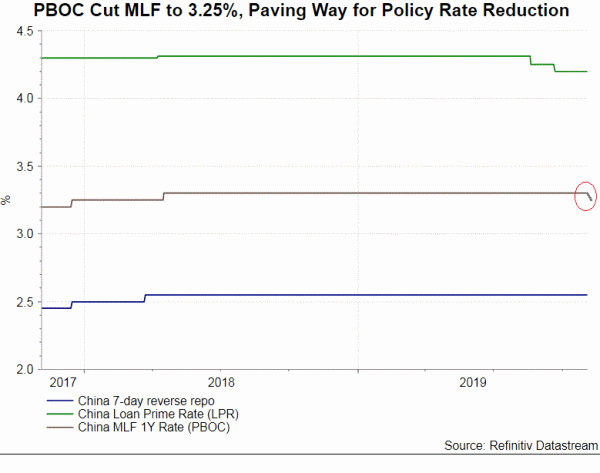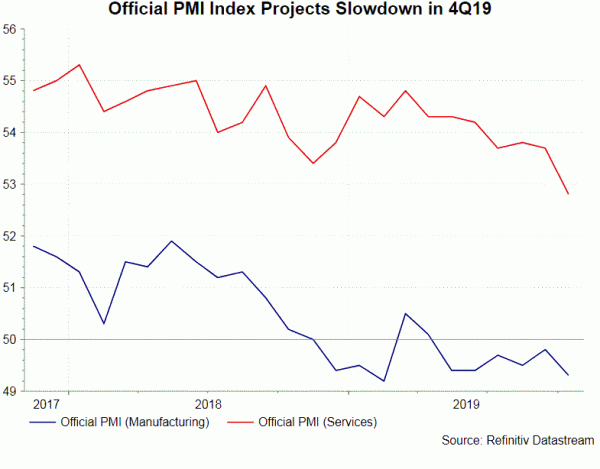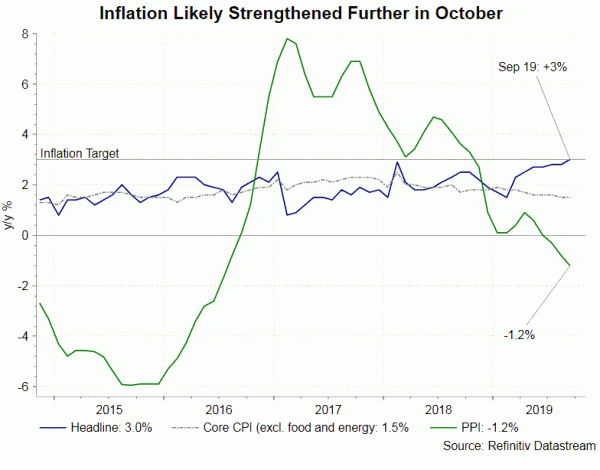For the first time in over 3 years, People’s Bank of China (PBOC) lowers the rate of the 1-year medium lending facility (MLF) by -5 bps to 3.25%. This surprising move underlines the rapid deterioration of domestic growth and paves the way for a cut in the loan prime rate (LRP), the current main policy rate, in coming weeks.
 Ahead of the release of October macroeconomic data, leading indicators pointed to further weakness. Official manufacturing PMI slipped -0.5 point to 49.3, while non-manufacturing PMI fell -0.9 point to 52.8, in October. The composite index was down -1.1 points to 52. A similar trend was seen in small and micro enterprises. Caixin’s manufacturing PMI dropped -0.3 point to 51.7, while services PMI was down -0.2 point to 51.1. Despite slowing growth, inflation would remain elevated, heightening the risk of stagflation. The market expects headline CPI to have risen to +3.3% y/y in October, from +3% a month ago. Food price, in particular pork price, is the major driving force. Upstream deflation will be more pronounced. The market expects PPI to have contracted -1.5%, after declining -1.2% in September.
Ahead of the release of October macroeconomic data, leading indicators pointed to further weakness. Official manufacturing PMI slipped -0.5 point to 49.3, while non-manufacturing PMI fell -0.9 point to 52.8, in October. The composite index was down -1.1 points to 52. A similar trend was seen in small and micro enterprises. Caixin’s manufacturing PMI dropped -0.3 point to 51.7, while services PMI was down -0.2 point to 51.1. Despite slowing growth, inflation would remain elevated, heightening the risk of stagflation. The market expects headline CPI to have risen to +3.3% y/y in October, from +3% a month ago. Food price, in particular pork price, is the major driving force. Upstream deflation will be more pronounced. The market expects PPI to have contracted -1.5%, after declining -1.2% in September.

 Strong inflation, coupled with decelerated growth, has created a policy dilemma for PBOC. While monetary easing is needed to stimulate growth, it would exacerbate inflation pressure, let alone soaring debts. Some officials have proposed to focus on core CPI, which is benign and supports the logic of further easing. Yet, further rise in food price could aggravate public discontent, something that the illegitimate Chinese government seeks to avoid.
Strong inflation, coupled with decelerated growth, has created a policy dilemma for PBOC. While monetary easing is needed to stimulate growth, it would exacerbate inflation pressure, let alone soaring debts. Some officials have proposed to focus on core CPI, which is benign and supports the logic of further easing. Yet, further rise in food price could aggravate public discontent, something that the illegitimate Chinese government seeks to avoid.
Today’s rate cut is too small to have real impact to the economy. Yet, it sends a signal that PBOC might turn more proactive in boosting the economy. Meanwhile, it paves the way for a reduction of LRP, the fixing of which will be determined on the 20th of each month.












